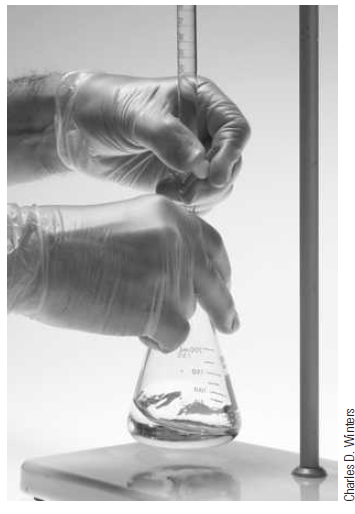

علم الكيمياء

تاريخ الكيمياء والعلماء المشاهير

التحاضير والتجارب الكيميائية

المخاطر والوقاية في الكيمياء

اخرى

مقالات متنوعة في علم الكيمياء

كيمياء عامة


الكيمياء التحليلية

مواضيع عامة في الكيمياء التحليلية

التحليل النوعي والكمي

التحليل الآلي (الطيفي)

طرق الفصل والتنقية


الكيمياء الحياتية

مواضيع عامة في الكيمياء الحياتية

الكاربوهيدرات

الاحماض الامينية والبروتينات

الانزيمات

الدهون

الاحماض النووية

الفيتامينات والمرافقات الانزيمية

الهرمونات


الكيمياء العضوية

مواضيع عامة في الكيمياء العضوية

الهايدروكاربونات

المركبات الوسطية وميكانيكيات التفاعلات العضوية

التشخيص العضوي

تجارب وتفاعلات في الكيمياء العضوية


الكيمياء الفيزيائية

مواضيع عامة في الكيمياء الفيزيائية

الكيمياء الحرارية

حركية التفاعلات الكيميائية

الكيمياء الكهربائية


الكيمياء اللاعضوية

مواضيع عامة في الكيمياء اللاعضوية

الجدول الدوري وخواص العناصر

نظريات التآصر الكيميائي

كيمياء العناصر الانتقالية ومركباتها المعقدة


مواضيع اخرى في الكيمياء

كيمياء النانو

الكيمياء السريرية

الكيمياء الطبية والدوائية

كيمياء الاغذية والنواتج الطبيعية

الكيمياء الجنائية


الكيمياء الصناعية

البترو كيمياويات

الكيمياء الخضراء

كيمياء البيئة

كيمياء البوليمرات

مواضيع عامة في الكيمياء الصناعية

الكيمياء الاشعاعية والنووية
Directions for Using a Buret
المؤلف:
D. A. Skoog, F. J.Holler, D M. West, and S. R. Crouch
المصدر:
Fundamentals of Analytical Chemistry
الجزء والصفحة:
9th - p40
5-4-2016
2559
Directions for Using a Buret
A buret must be scrupulously clean before it is used, and its valve must be liquid-tight.
Cleaning
Thoroughly clean the tube of the buret with detergent and a long brush. Rinse thoroughly with tap water and then with distilled water. Inspect for water breaks. Repeat the treatment if necessary.
Lubricating a Glass Stopcock
Carefully remove all old grease from a glass stopcock and its barrel with a paper towel and dry both parts completely. Lightly grease the stopcock, taking care to avoid the area adjacent to the hole. Insert the stopcock into the barrel and rotate it vigorously with slight inward pressure. A proper amount of lubricant has been used when (1) the area of contact between stopcock and barrel appears nearly transparent, (2) the seal is liquid-tight, and (3) no grease has worked its way into the tip.
Notes
- Grease films that are unaffected by cleaning solution may yield to such organic solvents as acetone or alcohols. Thorough washing with detergent should follow such treatment. Silicone lubricants are not recommended because contamination by such preparations is difficult—if not impossible—to remove.
- So long as the flow of liquid is not impeded, fouling of a buret tip with stopcock grease is not a serious matter. Removal is best accomplished with organic solvents. A stoppage during a titration can be freed by gentle warming of the tip with a lighted match.
- Before a buret is returned to service after reassembly, it is advisable to test for leakage. Simply fill the buret with water and establish that the volume reading does not change with time.
Filling
Make certain the stopcock is closed. Add 5 to 10 mL of the titrant, and carefully rotate the buret to wet the interior completely. Allow the liquid to drain through the tip. Repeat this procedure at least two more times. Then fill the buret well above the zero mark. Free the tip of air bubbles by rapidly rotating the stopcock and permitting small quantities of the titrant to pass. Finally, lower the level of the liquid just to or somewhat below the zero mark. Allow for drainage (, 1 min), and then record the initial volume reading, estimating to the nearest 0.01 mL.
Titration
Figure1 illustrates the preferred method for manipulating a stopcock. When you position your hand as shown, your grip on the stopcock tends to keep the stopcock firmly seated.

Figure 1 Recommended method for manipulating a buret stopcock.
Be sure the tip of the buret is well within the titration flask, and introduce the titrant in increments of about 1 mL. Swirl (or stir) constantly to ensure thorough mixing. Decrease the volume of the increments as the titration progresses, and add titrant drop by drop as you reach the immediate vicinity of the end point (Note 2). When it appears that only a few more drops are needed to reach the end point, rinse the walls of the container (Note 3). Allow the titrant to drain from the inner wall of the buret (at least 30 seconds) at the completion of the titration. Then record the final volume, again to the nearest 0.01 mL. Notes
- When unfamiliar with a particular titration, many workers prepare an extra sample. No care is taken with its titration since its functions are to reveal the nature of the end point and to provide a rough estimate of titrant requirements. This deliberate sacrifice of one sample frequently results in an overall saving of time.
- Increments smaller than one drop can be taken by allowing a small volume of titrant to form on the tip of the buret and then touching the tip to the wall of the flask. This partial drop is then combined with the bulk of the liquid as in Note 3.
- Instead of being rinsed toward the end of a titration, the flask can be tilted and rotated so that the bulk of the liquid picks up any drops that adhere to the inner surface.















 قسم الشؤون الفكرية يصدر مجموعة قصصية بعنوان (قلوب بلا مأوى)
قسم الشؤون الفكرية يصدر مجموعة قصصية بعنوان (قلوب بلا مأوى) قسم الشؤون الفكرية يصدر مجموعة قصصية بعنوان (قلوب بلا مأوى)
قسم الشؤون الفكرية يصدر مجموعة قصصية بعنوان (قلوب بلا مأوى) قسم الشؤون الفكرية يصدر كتاب (سر الرضا) ضمن سلسلة (نمط الحياة)
قسم الشؤون الفكرية يصدر كتاب (سر الرضا) ضمن سلسلة (نمط الحياة)

















